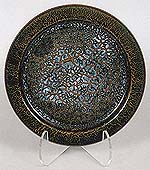|
AUTUMN'S CULTURAL HARVEST
Bringing simple beauty from the inside out
By ROBERT YELLIN
for The Japan Times, Oct. 14, 2000
Hot fun in the summertime has slowly segued into the cool cultural events of autumn, which is popularly known as "bunka no kisetsu (the cultural season)." Autumn not only brings delightful weather but also a slew of exhibitions and festivals to keep anyone's schedule topped off. Rest your weary overworked eyes and have a look at some of the following.
|
|
|
Small lidded vase
celadon glaze
|
|
In town from the United States is Brother Thomas Bezanson, showing at the Green Gallery in Tokyo in an exhibition titled "Pathways to Simplicity." The very Zen-sounding title of this exhibition leads one to believe that plain, earthy pieces will be the focus of Brother Thomas's work, but quite the contrary. The Nova Scotia-born Benedictine's work consists of luscious Chinese-influenced glazed pots that, when they work, are quite stunning. Possibly the notion of simplicity is in the forms. Most are quite sturdy and flawlessly made and, indeed, simple. They have to be, for any wacky shapes or off-balance forms would clash with the beauty of the glazes.
A Zen attitude also comes into play with Brother Thomas' spiritual approach to creating.
"When I work, I simply work," he writes in the exhibition's brochure. "I look upon it as a daily process I enter. I do not go into my studio with any agenda. I do not enter the working process with even the remotest idea that I'm going to create a masterpiece, even if I knew what a masterpiece was. Or, what a 'master' was for that matter." Has the man found satori or what?
Yet, he does bring up a very interesting question -- what is a masterpiece, and who decides so? I've seen kids' drawings that would definitely qualify and pricey art in fancy galleries that should have been tossed out with the morning's trash. It all comes down to a subjective judgment, and no group of 10 people will ever come to a consensus.
Still, I imagine that if they saw some of Brother Thomas' pieces they might all be seen nodding their heads in agreement.
|

|
|
Decorative plate,
textured black and
yellow iron glaze
|
|
His small decorative plates are magnificent, particularly four that are like mandalas and quite hypnotizing. Two have purple tones with crystal glazes and the others have a saffron iron yellow glaze and a textured black and yellow iron glaze. How does he do it? Again, as I've written before, it comes down to "unlearning" technique and working on the depth of your own spirit.
Brother Thomas agrees when he writes, "I realized that if I were to make the beautiful pot I first must make the beautiful person." I believe the beauty he speaks of is not something seen on the outside; it's a well within that is a quiet source of inspiration and grace from the gifts of nature and the joy of being alive.
|
|
|
Vase with cover,
copper red glaze
|
|
When I viewed his red copper lidded vase I thought I could hear a hymn coming from within its sacred inner sanctum. It flows with such mystery that I stared at the picture until I forgot time. And this is from a pottery lover who leans toward the "chilled and withered" look of high-fired unglazed stoneware, like Shigaraki or Bizen. I'm not a big fan of perfectly glazed work. So, there must be something going on here that has led to an ever-so-slight conversion.
Not all the pieces sing, though. His tea bowls don't seem to pull all the necessary elements together: the lip, the "prospect," the hips and the footring. Also, some of the glazes and forms have been done for centuries in China and Japan and really don't offer anything new to those familiar with such work; they seem almost trite from an Eastern viewpoint.
But I don't think that bothers Brother Thomas, for his work comes from his heart and not by way of any formula.
Art, as he writes, "is a meeting place where there are no strangers," and one does feel at home standing before a Brother Thomas pot.
Works by Brother Thomas until Oct. 28 at the Green Gallery, (03) 3401-5255, in Akasaka. Closed Sunday and Monday. The gallery is located near the Akasaka Mitsuke subway station. Exit onto Aoyama-dori and walk toward Aoyama until you come to a Doutor coffee shop and turn left there. The gallery is up that road on the right.
The Japan Times: Oct. 14, 2000
(C) All rights reserved
.
|